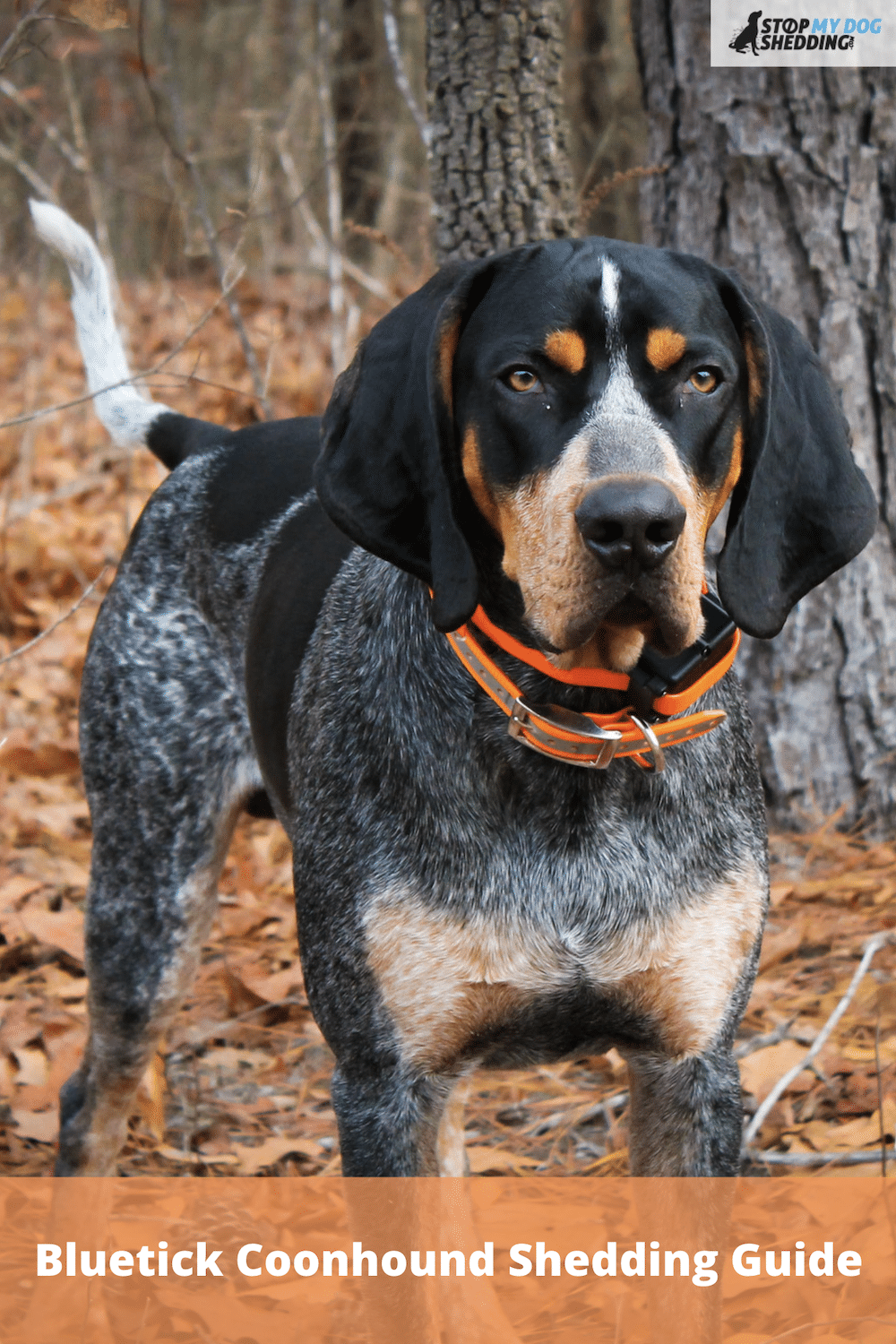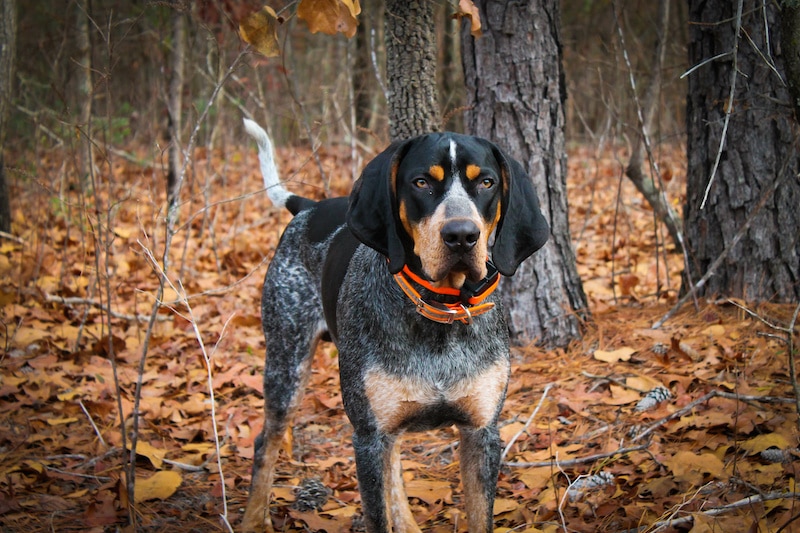The Bluetick Coonhound is a large dog that was bred for hunting raccoons. The dog is beloved for traits such as its bawl mouth, its usually cold nose, and its friendly demeanor.
You may be quite interested in adopting a Bluetick Coonhound, but since you’re here, I’m guessing you’re curious about how much the breed sheds?
Bluetick Coonhounds are moderate shedders despite the coarseness of the breed’s coat. The dog’s short fur likely plays a role in shedding. The coat length makes this breed easy to groom, as the Bluetick Coonhound only requires weekly brushing and infrequent baths.
This guide will tell you everything you need to know about Bluetick Coonhound shedding. I’ll also discuss the grooming requirements of this breed, whether the Bluetick Coonhound is considered hypoallergenic, and give you some background on this breed.
Let’s begin!
Recommended: Go here to see our top-rated dog hair blow dryers
Bluetick Coonhound Shedding
The Bluetick Coonhound is one of six Coonhound species. I wrote about all six here.
In that article, I briefly touched on the Bluetick Coonhound’s shedding propensity, so let’s go a little more in-depth here.
The Bluetick Coonhound has a short coat that’s somewhat coarse but feels smooth and glossy. That coat–as the name of this breed implies–is indeed often blue.
Fun fact: the reason for the coloration is that the background of the Bluetick Coonhound’s coat is white with black patterning and ticking atop that. This makes the coat look like a deep, dark blue.
Worry not, as the Bluetick Coonhound is a single-coated dog. This means you don’t have to worry about seasonal shedding spikes twice per year for weeks on end.
The coarseness of the coat also keeps the Bluetick Coonhound from shedding uncontrollably.
However, the length of this Coonhound’s coat doesn’t do him any favors.
All dogs grow and release fur across four stages. When a dog has longer fur, the duration from one stage to another increases.
A short-furred dog, on the other hand, typically goes through the hair growth cycle at a much faster rate. And that can mean that the dog sheds fur more frequently.
At least short fur doesn’t make as much of a mess as long tufts or strands of dog hair, though. And as I’ll now explain, the grooming side of things is a sinch with this breed.
Grooming Your Bluetick Coonhound
The key to a healthy-looking and feeling Bluetick Coonhound coat is regular grooming.
It’s important to brush the Bluetick Coonhound. Since its coat is short, you can get away with weekly brushing. I’d recommend using a rubber hand glove or a medium-sized bristle brush.
The shortness of the fur–in combination with the single-coated status of the Bluetick Coonhound–makes this breed exceptionally easy to brush.
You don’t have to worry about mats or tangles in the Coonhound’s fur. You can quickly comb over the dog’s body and be done.
Brushing your dog, even if he does have short fur, such as the Bluetick Coonhound, is beneficial for a variety of reasons.
You can spread oils that maintain skin moisture. Your dog won’t feel dry and itchy, which prevents premature fur loss.
The Bluetick Coonhound is already known for its coat sheen, but you can make its fur even shinier by brushing!
Plus, you pull out all those loose, small dead hairs, so they don’t create a layer of fuzz on your couch or clothing.
You shouldn’t have to worry about trimming this breed, thanks to its close-cropped fur. That’s one less thing to do!
The Bluetick Coonhound doesn’t need baths all that often, maybe once every couple of months or when the dog starts to smell, whichever comes first.
When you do bathe your Coonhound, be sure to use a shampoo formulated for dogs. Follow the usage instructions too.
Human shampoo can be irritating to a dog’s skin, as can overusing dog-friendly shampoo. In both cases, your Bluetick Coonhound can end up with dry, itchy, irritated skin that could make them shed.
You can wash your Bluetick Coonhound in an empty, clean bathtub. Be sure to rinse away all the shampoo residue before you let the dog out of the tub.
You should be safe to towel-dry your pup, considering his fur won’t knot or tangle.
Reducing Excessive Shedding
Although a Bluetick Coonhound should shed moderately, if yours is shedding to excess, it’s important to determine what’s causing the shedding.
I would recommend starting with your Bluetick Coonhound’s grooming habits. If you’re following the above brushing and bathing instructions, then that should control your dog’s shedding well enough.
If not their grooming, then it could be that your Bluetick Coonhound has a nutrient deficiency.
Their diet should be full of nutrients, minerals, and vitamins. You may need to add omega-3 fatty acid supplements to your dog’s diet but be sure to ask your vet.
Some people also like to try coconut oil as a supplement for shedding, which is full of medium-chain triglycerides or MCTs. This beneficial fat is a great addition to your dog’s diet. But as with anything, moderation is important, and before making any changes to your dog’s diet, it’s best to speak with a veterinarian.
If your dog isn’t in the mood for yet another supplement, ask your vet about applying MCT oil topically. It has a similar effect.
A diet that’s full of preservatives could contain ingredients that your dog is allergic to. Having food allergies could lead to more itching and scratching.
You’ll have to take your Bluetick Coonhound to a vet to determine a potential food allergy. The way a vet rules out allergies is by removing common food ingredients one by one until they find the culprit.
Be sure to forego buying dog food with the allergen to keep your pup from itching.
To know more about reducing excessive shedding, see our complete guide.
Are Bluetick Coonhounds Hypoallergenic?
Dogs may be a great joy to most of us, but for those who suffer from pet dander allergies, that isn’t the case.
You might have heard that hypoallergenic dogs reduce allergy symptoms, which is what got you interested in a Bluetick Coonhound in the first place. Is this Coonhound breed hypoallergenic?
No, the Bluetick Coonhound is not hypoallergenic.
There are two factors that usually go into how hypoallergenic a dog breed is: size and shedding habits.
As I touched on in the intro, the Bluetick Coonhound is a big dog. Males are 22 to 27 inches tall and weigh between 55 and 80 pounds.
Females are 21 to 25 inches tall and can weigh up to 65 pounds, so they’re not much lighter.
The reason that smaller dogs are more hypoallergenic is that they have less surface area. The Bluetick Coonhound has no shortage of surface area, that’s for sure!
The other trait of a hypoallergenic dog, which is shedding little, doesn’t fit the Bluetick Coonhound either.
He’s not the highest shedding of all the Coonhounds, but the Bluetick Coonhound can release plenty of fur.
While it’s unfortunate that the Bluetick Coonhound isn’t hypoallergenic, the definition of a hypoallergenic dog is easily confused anyway.
A hypoallergenic canine will typically cause fewer allergy symptoms, but the symptoms are still there.
Why is that? Someone who is allergic to pet dander gets itchy and sneezy when exposed to dead skin flakes, as that’s what dander is.
All dogs have skin, so thus all dogs can cause dander allergies to flare.
Recommended: Go here to see our top-rated dog hair blow dryers
About Bluetick Coonhounds
Are you debating whether adopting a Bluetick Coonhound is the best choice for the entire family? Here is some handy info that will aid in your decision-making.
The Bluetick Coonhound comes from the United States. The large dog was originally bred for hunting raccoons. That’s evidenced in this Coonhound’s muscular frame.
Above all, the Bluetick Coonhound is a friendly, kind dog that’s also described as determined, loyal, and intelligent. He’s eager to please and trains easily.
I wouldn’t recommend a Bluetick Coonhound for apartment dwellers, though.
For one, the dog is too big to be comfortable all cooped up. On top of that, this Coonhound has a lot of energy to burn and needs plenty of outdoor space in which to burn it.
The Bluetick Coonhound prefers to be mentally stimulated as well, requiring an activity or job to keep him occupied. That’s easier to do with more space.
The Bluetick Coonhound is typically quite good with other dogs, although they might get competitive if they feel like they’re not the dominant dog. Socialization is critical.
Smaller pets such as cats or hamsters are not the best friend of a Bluetick Coonhound. As a raccoon hunter, the Coonhound will try to catch smaller creatures. A cat that’s already used to dogs would fare best.
The kind demeanor of a Bluetick Coonhound makes this breed a reliable family companion and good around children. It’s still important to socialize your dog, though.
The Bluetick Coonhound is highly vocal and will bark and bawl a lot. You might want to consider behavioral training if your dog’s barking is getting too many complaints from the neighbors.
Here’s a cool video I found about the Bluetick Coonhound that you may find helpful if you want to know more about this breed:
Recommended: Go here to see our top-rated dog hair blow dryers
Bottom Line
The Bluetick Coonhound is a large hunting dog in the Coonhound family with short, coarse, blue fur. The breed sheds moderately but is considered very easy to groom, mostly due to that close-cropped coat.
And with its friendly personality and striking looks, there’s a lot to love about the Bluetick Coonhound.
Do you have a Bluetick Coonhound? If so, what has your experience been with shedding and grooming? Let us know in the comments below!













Please note: By submitting a comment using the above comment form, you confirm that you agree with the storage and handling of your data by this site as detailed in our Privacy Policy.